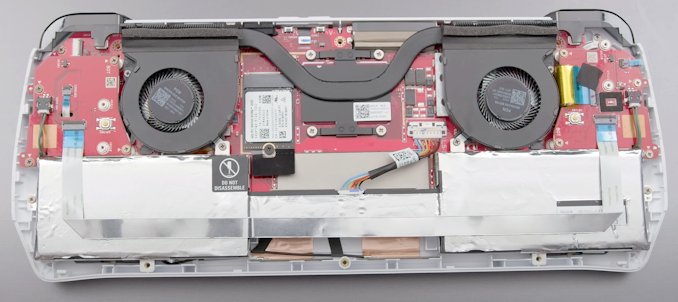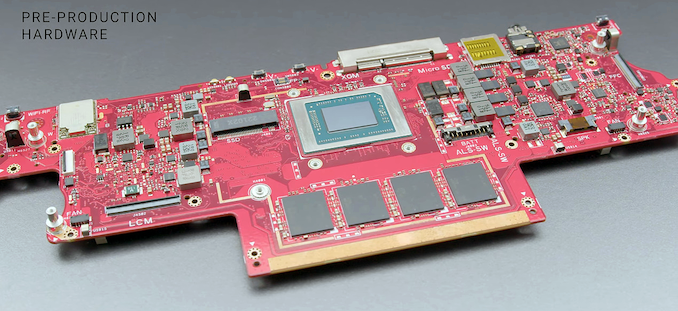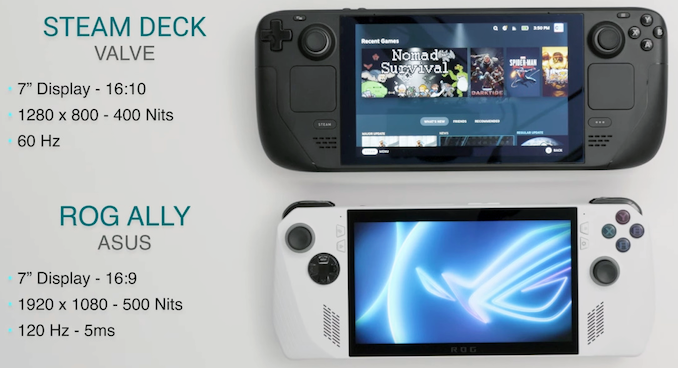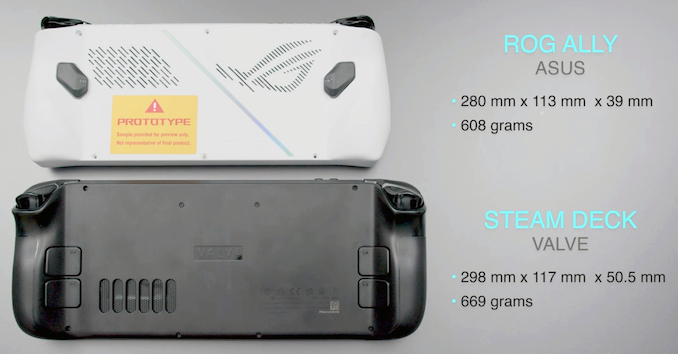Asus Preps ROG Ally: A Portable Windows Game Console with Custom Zen 4 + RDNA 3 APU
by Anton Shilov on April 5, 2023 1:00 PM EST
Asus has begun teasing its own portable game console, the ROG Ally, which the company is positioning as a high-end offering for the handheld PC gaming market. With its ROG Ally, Asus is certainly trying to join in on the rise of portable x86-based game consoles, which have been inspired by the Steam Deck system and further stimulated by game developers' enthusiasm to optimize their titles for these portable low-power PCs.
This weeks reveal, which included a questionably timed April Fool's joke that was, in, fact, not a joke, is less of an announcement and more of a teaser on what Asus is working on. As such, Asus hasn't revealed much in the way of detailed specifications, let alone a release date or pricing. None the less, the company feels confident enough in the product at this point that they're showing off a prototype to whet gamers appetites ahead of what's presumably a proper release later this year.
Starting at the heart of Asus's handheld console, CPU and GPU are corner stones of every gaming system. So for its ROG Ally Asus picked up what they are calling a custom AMD system-on-chip featuring Zen 4 general purpose cores as well as an RDNA 3-based integrated GPU. The SoC is made by TSMC on one of its N4 process technologies (4nm-class), though its configuration is unknown and we have no idea whether ROG Ally uses what's just a semi-custom configuration of one of AMD's Phoenix APUs, or if indeed uses a truly custom-designed SoC with certain perks exclusive for the console.

(Image credit: Dave2D)
The Asus ROG Ally comes with a proprietary connector which is divided into two part: one part transmits PCIe 3.0 x8 data, while the other part is a USB-C connector responsible for transmitting power and USB data. That connector, in turn, can be used to attach an external Asus ROG XG Mobile dock with an external GPU (up to GeForce RTX 4090 Laptop GPU) and external display connectors, essentially transforming the portable game console into a higher performance desktop gaming system. While most portable game consoles can work with external displays and some can even attach an external GPU (albeit with some tricks), enabling this capability by default is one of the major features Asus is counting on to differentiate its ROG Ally.

(Image credit: Dave2D)
The Alloy's custom APU, in turn, will be used to drive a 7-inch Full-HD (1080p) display, which offers a maximum brightness up to 500 nits brightness as well as an up to 120 Hz refresh rate. The inclusion of such a high performance display on a battery-constrained device is certainly an interesting choice, and while at first blush it sounds like it may be overkill, YouTuber Dave2D, who was one of only two people to get an early look at the console, says that the built-in GPU can indeed take advantage of a higher refresh rate.
As far as other hardware peculiarities are concerned, the Asus ROG Ally console uses soldered-down (presumably) LPDDR5 memory, an M.2-2230 NVMe SSD, a Wi-Fi and Bluetooth adapter, a MicroSD card slot, a USB Type-C port for charging and display output, and a TRRS audio connector for headsets.

(Image credit: Dave2D)
When it comes to software, Asus ROG Ally runs Microsoft's Windows 11 operating system and should be compatible with all contemporary games developed for the Windows platform, including those available from Steam, Epic Games Store, and Xbox Game Pass. This is of course a significant trump that the Asus ROG Ally has over Valve's Steam Deck, which runs a custom version of Linux and is not compatible with all games – but getting desktop Windows to play nicely with handheld computers has also historically come with its own set of challenges.
With all of that said, Steam Deck still has an edge over ROG Ally when it comes to ergonomics, according to Dave2D. Yet, the Asus portable game console is quieter and can run cooler when working in a 15W mode.

(Image credit: Dave2D)
The Asus ROG Ally game console certainly looks impressive from hardware standpoint. Meanwhile, its software is in the early stages of development, according to the Dave2D, which suggests that this one is not going to be available shortly. This is perhaps why Asus decided not to disclose final specifications of the game console and only gave it to two YouTubers for a test run.
Asus reportedly says that the price of the ROG Ally console will be competitive, though this is a pretty vague statement as if it performs two times faster than Valve's Steam Deck ($699) and is priced roughly 50% higher (say $999 - $1099), one may say that as its price performance ratio is so good, its price is competitive. Meanwhile, good news is that Asus will release its unit globally.
In any case, Asus's attempt to enter the market of portable gaming console looks inspiring from hardware standpoint (i.e., on paper). It remains to be seen how comfortable it is to use the console, as well as how much it ends up costing and just how long the high-specced device can be used on the go.
Source: Asus










18 Comments
View All Comments
brucethemoose - Wednesday, April 5, 2023 - link
> though its configuration is unknown and we have no idea whether ROG Ally uses what's just a semi-custom configuration of one of AMD's Phoenix APUs, or if indeed uses a truly custom-designed SoC with certain perks exclusive for the console.There's no way they could tape out a new chip and make this thing profitable. Some call the Deck chip "fully custom" but (because of a Videocardz leak in 2020, search for "Videocardz Van Gogh") I think its a repurposed laptop chip too.
Apparently Asus mentioned close integration with Gamepass... which is smart, as Microsoft essentialy culls and verifies controller supper for Asus here.
They also mentioned Armory Crate as the interface, which is *NOT* great. AC is an absolute pig on my ROG laptop, and (with an alternative to control power states) battery life shoots up with it uninstalled. That is going to be even more dramatic in the Ally, which doesn't have the TDP budget to burn power on background junk like a dGPU laptop does.
thestryker - Wednesday, April 5, 2023 - link
The Steam Deck very much is a custom SoC as it uses Zen 2 CPU bits with RDNA 2 GPU and a custom memory controller. Chips and Cheese did an analysis on it and went over the varying parts of the SoC.While the Ally has no reason to be as custom given that it's using all modern pieces it could easily be a lower end 6 core CPU combined with the full GPU which isn't a configuration AMD sells.
xol - Wednesday, April 5, 2023 - link
Interesting thing about the Steam Deck/PS5/XboxSeries is that they are all "custom" with RDNA2/Zen2(laptop) chips .. it's almost like AMD had a standard design and offered variants of it to different buyers with different core/CU counts.Nothing odd there. What is odd is that they never made it available to consumers directly (or non console hardware makers afaik) - and stuck with GCN up to 2021. Not sure why..
NeuralNexus - Wednesday, April 5, 2023 - link
It's likely that AMD wanted to refine the RDNA architecture and drivers before offering that as a custom option for all of the non-console hardware makers.brucethemoose - Wednesday, April 5, 2023 - link
I dont think this is true either. The PS5 and XSX have tons of really weird, very nonstandard accelerators baked into them.I think Renoir (Ryzen 4000) was "old" which is why it was GCN: RDNA2 was just not ready for Windows yet.
Cezzane (Ryzen 5000) seemed like a low cost Renoir tweak, with conspicuous empty area in the die around where they "swapped" the Zen 3 cores in. Maybe switching to RDNA2 would have required a full redesign, which is exactly what Rembrandt is.
lmcd - Friday, April 7, 2023 - link
AMD desperately needed OEM prebuilt money, and OEMs want iGPs, and they want stagnant platforms. AMD's chipsets were mostly drop-in replacements even if you did pair Ryzen generation with chipset generation, with minimal change. That means the iGP was staying the same architecture basically no matter what.Cezanne might've been an adaptation of Renoir -- my alternate theory is that it was an adaptation of Rembrandt backported with DDR4 and Vega for the sake of delivering an OEM product (which then became useful with GPU prices as direct-to-consumer, especially with backlash over Ryzen 4000 being OEM-only at first).
Ryzen 4000 Renoir then gets rebranded to Ryzen 5000 with some clock tweaks on the low end, and Rembrandt slots in at the top of Ryzen 5000 high end laptops (and doesn't ship to desktop).
My theory stems from that Rembrandt's "uncore" (for lack of a better word) is both late and underperforming expectations, which is by no coincidence where Zen 4 has struggled on desktop re: memory controller, and is the primary differentiator between Cezzane (shipped arguably ahead of schedule, in high volume and seemingly-high yields) and Rembrandt (low volume, will probably sell more total units as Ryzen 7000 than 6000).
thestryker - Wednesday, April 5, 2023 - link
The PS5 CPU core features a cut down FPU, but I don't believe the Xbox one is much different from the desktop Zen 2 CPUs. AMD does these custom designs all the time and it just varies how big the differences are. They do custom variants for laptop OEMs fairly regularly which tend to have very small differences.brucethemoose - Wednesday, April 5, 2023 - link
The customized laptop variants are not new dies, are they?thestryker - Wednesday, April 5, 2023 - link
Those usually just had different clocks on the CPU side, but sometimes different graphics configuration so these were maybe binned die, but I'm not familiar enough with vega to say one way or another on that part.brucethemoose - Wednesday, April 5, 2023 - link
Its not though, as a slide from 2020 in that Videocardz article shows it as a low power laptop part alongside Cezzane.This is pure speculation on my part, but I think laptop OEMs passed on it, but Valve swooped in and picked it up because it was *exactly* what they needed.